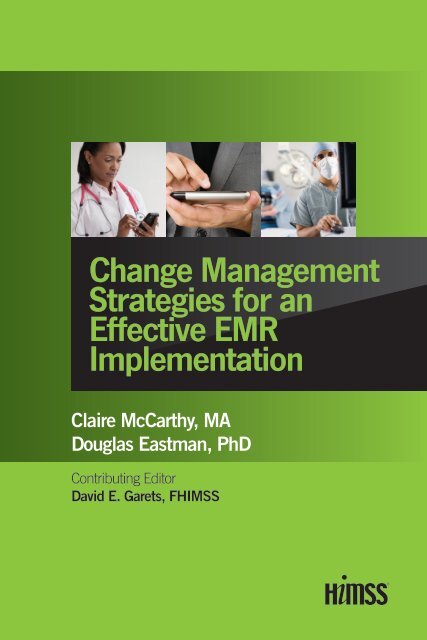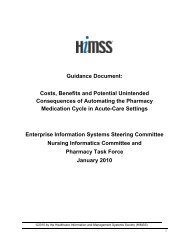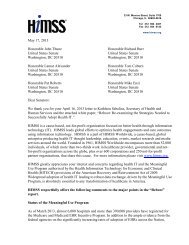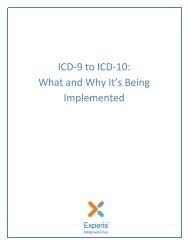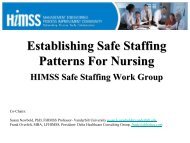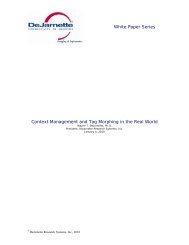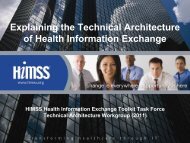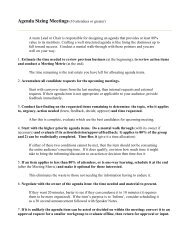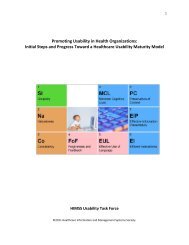Change Management Strategies for an Effective EMR ... - HiMSS
Change Management Strategies for an Effective EMR ... - HiMSS
Change Management Strategies for an Effective EMR ... - HiMSS
You also want an ePaper? Increase the reach of your titles
YUMPU automatically turns print PDFs into web optimized ePapers that Google loves.
<strong>Ch<strong>an</strong>ge</strong> <strong>M<strong>an</strong>agement</strong><br />
<strong>Strategies</strong> <strong>for</strong> <strong>an</strong><br />
<strong>Effective</strong> <strong>EMR</strong><br />
Implementation<br />
Claire McCarthy, MA<br />
Douglas Eastm<strong>an</strong>, PhD<br />
Contributing Editor<br />
David E. Garets, FHIMSS
<strong>Ch<strong>an</strong>ge</strong> <strong>M<strong>an</strong>agement</strong> <strong>Strategies</strong><br />
<strong>for</strong> <strong>an</strong> Eff ective<br />
<strong>EMR</strong> Implementation<br />
Claire McCarthy, MA<br />
Douglas Eastm<strong>an</strong>, PhD<br />
Contributing Editor<br />
David E. Garets, FHIMSS
HIMSS Mission<br />
To lead healthcare tr<strong>an</strong>s<strong>for</strong>mation through the eff ective use of<br />
health in<strong>for</strong>mation technology.<br />
© 2010 by the Healthcare In<strong>for</strong>mation <strong>an</strong>d <strong>M<strong>an</strong>agement</strong> Systems<br />
Society.<br />
All rights reserved. No part of this publication may be reproduced,<br />
adapted, tr<strong>an</strong>slated, stored in a retrieval system, or tr<strong>an</strong>smitted in<br />
<strong>an</strong>y <strong>for</strong>m or by <strong>an</strong>y me<strong>an</strong>s, electronic, mech<strong>an</strong>ical, photocopying,<br />
recording, or otherwise, without the prior written permission of<br />
the publisher.<br />
Printed in the U.S.A. 5 4 3 2 1<br />
Requests <strong>for</strong> permission to reproduce <strong>an</strong>y part of this work should<br />
be sent to:<br />
Permissions Editor<br />
HIMSS<br />
230 E. Ohio St., Suite 500<br />
Chicago, IL 60611-3270<br />
cmcle<strong>an</strong>@himss.org<br />
ISBN: 978-0-9821070-6-5<br />
Th e inclusion of <strong>an</strong> org<strong>an</strong>ization name, product or service in<br />
this publication should not be construed as <strong>an</strong> endorsement of<br />
such org<strong>an</strong>ization, product or service, nor is the failure to include<br />
<strong>an</strong> org<strong>an</strong>ization name, product or service to be construed as<br />
disapproval.<br />
For more in<strong>for</strong>mation about HIMSS, please visit www.himss.org.
About the Authors<br />
Claire McCarthy, MA, is a recognized ch<strong>an</strong>ge m<strong>an</strong>agement/technology<br />
adoption strategist <strong>an</strong>d leader with extensive experience supporting<br />
people through tr<strong>an</strong>sitions driven by soft ware implementations,<br />
mergers, reorg<strong>an</strong>izations, process improvements, <strong>an</strong>d downsizing in<br />
the healthcare industry. Ms. McCarthy works with healthcare providers<br />
<strong>an</strong>d staff at all levels. She advocates <strong>for</strong> the front line, underst<strong>an</strong>ding<br />
that developing willingness <strong>an</strong>d ability in people is what makes<br />
ch<strong>an</strong>ge successful <strong>an</strong>d produces lasting results. She speaks internationally<br />
on the topic of technology adoption, encouraging healthcare leaders<br />
to invest in the people side of electronic medical record (<strong>EMR</strong>)<br />
implementations.<br />
As Director of Org<strong>an</strong>izational Eff ectiveness <strong>for</strong> Kaiser Perm<strong>an</strong>ente’s<br />
national electronic medical records deployment, Ms. McCarthy<br />
introduced the concept of technology adoption to the org<strong>an</strong>ization<br />
<strong>an</strong>d led a national community of practice focused on developing user<br />
readiness. Th rough integration of cross-functional work in ch<strong>an</strong>ge<br />
m<strong>an</strong>agement, training, communication, union engagement, operations,<br />
lessons learned <strong>an</strong>d work<strong>for</strong>ce pl<strong>an</strong>ning, clinical <strong>an</strong>d business<br />
users were prepared to assume new roles <strong>an</strong>d responsibilities in support<br />
of org<strong>an</strong>izational objectives.<br />
With 25 years of healthcare industry technology adoption experience,<br />
Ms. McCarthy has designed <strong>an</strong>d led the hum<strong>an</strong> side of technical<br />
implementations in a wide variety of soft ware deployments, including<br />
<strong>EMR</strong>s, practice m<strong>an</strong>agement, material m<strong>an</strong>agement/supply chain, client<br />
relationship m<strong>an</strong>agement, contracting <strong>an</strong>d sourcing, e-commerce,<br />
health pl<strong>an</strong> product m<strong>an</strong>agement, <strong>an</strong>d, currently, ICD-10 conversion.<br />
Ms. McCarthy is a certifi ed William Bridges Org<strong>an</strong>izational<br />
<strong>Ch<strong>an</strong>ge</strong> practitioner <strong>an</strong>d is accredited in Accelerating Implementation<br />
Methodology from Implementation <strong>M<strong>an</strong>agement</strong> Associates, Inc. She<br />
holds a master’s degree in sociology from the University of Mont<strong>an</strong>a<br />
<strong>an</strong>d a bachelor’s degree in sociology from Cali<strong>for</strong>nia State University.<br />
iii
iv <strong>Ch<strong>an</strong>ge</strong> <strong>M<strong>an</strong>agement</strong> <strong>Strategies</strong> <strong>for</strong> <strong>an</strong> Eff ective <strong>EMR</strong> Implementation<br />
Doug Eastm<strong>an</strong>, PhD, is <strong>an</strong> org<strong>an</strong>izational development executive with<br />
extensive experience m<strong>an</strong>aging large-scale ch<strong>an</strong>ge initiatives. With<br />
more th<strong>an</strong> 20 years of consulting experience, Dr. Eastm<strong>an</strong>’s focus is<br />
to help org<strong>an</strong>izations grow <strong>an</strong>d m<strong>an</strong>age ch<strong>an</strong>ge by unleashing hum<strong>an</strong><br />
potential. His specialties are org<strong>an</strong>izational tr<strong>an</strong>s<strong>for</strong>mation; technology<br />
adoption <strong>an</strong>d optimization; process redesign; large-scale ch<strong>an</strong>ge<br />
m<strong>an</strong>agement; strategic pl<strong>an</strong>ning; program <strong>an</strong>d tools development; <strong>an</strong>d<br />
facilitation.<br />
As the Executive Director of Technology Adoption <strong>an</strong>d Org<strong>an</strong>izational<br />
Capability within the Kaiser Perm<strong>an</strong>ente In<strong>for</strong>mation Technology<br />
Care Delivery Business In<strong>for</strong>mation Offi ce, Dr. Eastm<strong>an</strong> currently<br />
advises senior operational <strong>an</strong>d project executives on the country’s largest<br />
private <strong>EMR</strong> system implementation. Dr. Eastm<strong>an</strong> leverages best<br />
practices from across the program <strong>an</strong>d develops implementation readiness<br />
tools <strong>an</strong>d methodologies, as well as pioneering several best practice<br />
post go-live optimization strategies <strong>an</strong>d programs aimed to ensure<br />
end-users are building the requisite level of system skill profi ciency.<br />
Prior to joining Kaiser Perm<strong>an</strong>ente, Dr. Eastm<strong>an</strong>’s consulting career<br />
included positions with Andersen Consulting (now Accenture), Watson<br />
Wyatt Worldwide, <strong>an</strong>d a boutique employee relations consulting<br />
fi rm. He was also vice president of operations <strong>for</strong> a technology services<br />
fi rm <strong>for</strong> which he was responsible <strong>for</strong> the comp<strong>an</strong>y’s restructuring <strong>an</strong>d<br />
repositioning in its marketplace that grew 200% during his tenure.<br />
Dr. Eastm<strong>an</strong> serves on the board of directors <strong>for</strong> the Childhood<br />
Anxiety Network. He holds a PhD in org<strong>an</strong>izational psychology from<br />
the Cali<strong>for</strong>nia School of Professional Psychology, a master’s degree in<br />
psychology from Pepperdine University, <strong>an</strong>d a bachelor’s degree from<br />
Ohio State University.<br />
ABOUT THE CONTRIBUTING EDITOR<br />
David E. Garets, FHIMSS, is President <strong>an</strong>d CEO of HIMSS Analytics<br />
<strong>an</strong>d Executive Vice President of HIMSS. Mr. Garets has 32 years of<br />
experience in in<strong>for</strong>mation technology. Be<strong>for</strong>e joining HIMSS Analytics<br />
in 2004, he was Executive Vice President at Healthlink. Prior to<br />
that, he was Group Vice President, Healthcare Industry Research <strong>an</strong>d<br />
Advisory Services at Gartner. Previously, he was Senior M<strong>an</strong>ager in<br />
Emerging Practices at First Consulting Group <strong>an</strong>d CIO of Magic Val-
About the Authors v<br />
ley Regional Medical Center in Twin Falls, Idaho. Prior to working in<br />
the healthcare industry, Mr. Garets spent 13 years in various m<strong>an</strong>agement<br />
capacities <strong>for</strong> AT&T.<br />
Mr. Garets was a course director <strong>an</strong>d served on the faculties of the<br />
College of Healthcare In<strong>for</strong>mation <strong>M<strong>an</strong>agement</strong> Executives (CHIME)<br />
In<strong>for</strong>mation <strong>M<strong>an</strong>agement</strong> Executive Courses <strong>for</strong> 11 years. He serves<br />
on the editorial advisory boards of three healthcare in<strong>for</strong>mation technology<br />
journals <strong>an</strong>d magazines <strong>an</strong>d the board of directors of HIMSS<br />
Analytics. He is <strong>an</strong> affi liate professor at the Medical College of Virginia<br />
at Virginia Commonwealth University.<br />
Mr. Garets is a HIMSS Fellow, <strong>an</strong>d was chair of the HIMSS Board<br />
<strong>for</strong> 2003-2004. He is <strong>an</strong> internationally known author <strong>an</strong>d speaker on<br />
in<strong>for</strong>mation technologies, strategies, benchmarking, <strong>an</strong>d the future of<br />
healthcare. Mr. Garets has a bachelor’s degree in business administration<br />
from Texas Tech University.
Contents<br />
Foreword by David E. Garets, FHIMSS .................................................. ix<br />
Preface by Claire McCarthy, MA, <strong>an</strong>d Douglas Eastm<strong>an</strong>, PhD .......... xi<br />
Acknowledgments .................................................................................. xvii<br />
Chapter 1: Th e Business Case <strong>for</strong> <strong>Ch<strong>an</strong>ge</strong> <strong>M<strong>an</strong>agement</strong> .................. 1<br />
Section 1: Leadership—Establishing a Foundation <strong>for</strong> <strong>Ch<strong>an</strong>ge</strong> .... 21<br />
Chapter 2: Vision ................................................................................. 23<br />
Chapter 3: Sponsorship ....................................................................... 37<br />
Chapter 4: Org<strong>an</strong>izational Readiness Team ..................................... 55<br />
Section 2: Willingness—Building Commitment .............................. 77<br />
Chapter 5: Stakeholder <strong>M<strong>an</strong>agement</strong> ................................................ 79<br />
Chapter 6: Communication ............................................................... 95<br />
Section 3: Ability—Developing Requisite Skill ............................... 109<br />
Chapter 7: Training Strategy ............................................................ 111<br />
Chapter 8: Rein<strong>for</strong>cement ................................................................ 127<br />
Chapter 9: Implementation Readiness ............................................ 137<br />
Section 4: Summary .............................................................................. 175<br />
Chapter 10: Th e Journey ................................................................... 177<br />
References ............................................................................................. 185<br />
Index ........................................................................................................ 187<br />
vii
Foreword<br />
By David E. Garets, FHIMSS<br />
Electronic medical record (<strong>EMR</strong>) deployments are not about technology.<br />
Th ey are about equipping org<strong>an</strong>izations to reach critical business<br />
objectives by providing people with technical capabilities that make<br />
new things possible <strong>an</strong>d by engaging people in ch<strong>an</strong>ging their behavior<br />
to eff ectively use the new capabilities to generate results.<br />
Th is book will show you how to create <strong>an</strong> environment <strong>for</strong> success<br />
in your org<strong>an</strong>ization to not only ensure that your <strong>EMR</strong> implementation<br />
eff ort is successful but that your org<strong>an</strong>ization builds ch<strong>an</strong>ge<br />
capacity <strong>an</strong>d fl exibility in the process. Th is new nimbleness will serve<br />
you well in our world of continual ch<strong>an</strong>ge.<br />
Defi ning ch<strong>an</strong>ge m<strong>an</strong>agement is as import<strong>an</strong>t as underst<strong>an</strong>ding<br />
what ch<strong>an</strong>ge m<strong>an</strong>agement is not. It isn’t project m<strong>an</strong>agement or<br />
solely process improvement. Rather, it is a set of specifi c disciplines,<br />
described in detail in this book that, when coordinated <strong>an</strong>d integrated,<br />
make the diff erence between tossing money into <strong>an</strong> <strong>EMR</strong> pit (similar<br />
to the ones that we boaters throw our money into!) or getting the<br />
sought-aft er ch<strong>an</strong>ges in your org<strong>an</strong>ization.<br />
Chapter 2 on Vision is especially import<strong>an</strong>t. In it, Claire <strong>an</strong>d Doug<br />
explain how leadership paints the picture of what is expected from<br />
the implementation of <strong>an</strong> <strong>EMR</strong>. I would argue that it is a process that<br />
involves not only representatives of the front line <strong>an</strong>d their m<strong>an</strong>agers<br />
<strong>an</strong>d the senior executive team, but also the board. An <strong>EMR</strong> implementation<br />
done right—me<strong>an</strong>ing the technology works, was implemented<br />
on time <strong>an</strong>d within budget, <strong>an</strong>d the people modify their behavior <strong>an</strong>d<br />
processes to achieve commensurate value <strong>for</strong> the investment—is more<br />
tr<strong>an</strong>s<strong>for</strong>mative th<strong>an</strong> <strong>an</strong>ything else a healthcare org<strong>an</strong>ization could do.<br />
It needs to be driven from the board. Th at way the right people, i.e.,<br />
the CEO <strong>an</strong>d executive m<strong>an</strong>agement team, are held accountable <strong>for</strong> the<br />
ix
x <strong>Ch<strong>an</strong>ge</strong> <strong>M<strong>an</strong>agement</strong> <strong>Strategies</strong> <strong>for</strong> <strong>an</strong> Eff ective <strong>EMR</strong> Implementation<br />
success of this crucial business initiative with <strong>an</strong> in<strong>for</strong>mation technology<br />
component.<br />
Dale S<strong>an</strong>ders, then CIO at the Northwestern Medical Faculty Foundation<br />
<strong>an</strong>d now CIO at the Caym<strong>an</strong> Isl<strong>an</strong>ds’ Health Services Authority,<br />
pointed out that “you need to dedicate the time <strong>an</strong>d resources to<br />
const<strong>an</strong>tly iterate, refi ne, <strong>an</strong>d improve the utilization of the <strong>EMR</strong> over<br />
time, far beyond its installation <strong>an</strong>d go-live. It’s a race without a fi nish<br />
line. Train, fund <strong>an</strong>d pl<strong>an</strong> accordingly—don’t short-ch<strong>an</strong>ge the<br />
investment!” In other words, recognize that you are not done at golive;<br />
you’ve just started achieving technology adoption <strong>an</strong>d ch<strong>an</strong>ging<br />
behavior to get value from your <strong>EMR</strong> investment.<br />
Th is book should be required reading <strong>for</strong> every member of the<br />
executive team in every healthcare org<strong>an</strong>ization that is pl<strong>an</strong>ning to<br />
implement <strong>an</strong> <strong>EMR</strong> in the next few years. I was happy to be asked<br />
to review the book <strong>an</strong>d to write the <strong>for</strong>eword—<strong>an</strong>d not <strong>for</strong> the fame<br />
<strong>an</strong>d <strong>for</strong>tune! It was because I would then have to read it, <strong>an</strong>d I’m glad<br />
I did. I learned <strong>an</strong> incredible amount about a topic that most of us in<br />
the technology world do not underst<strong>an</strong>d well <strong>an</strong>d that is, dealing with<br />
people issues. Claire <strong>an</strong>d Doug nail it here, <strong>an</strong>d I guar<strong>an</strong>tee you’ll be<br />
th<strong>an</strong>kful <strong>for</strong> the knowledge they share.<br />
Having said that, reading this defi nitive work on ch<strong>an</strong>ge m<strong>an</strong>agement<br />
<strong>for</strong> <strong>EMR</strong> implementations is not going to provide you with<br />
enough knowledge on the topic to preclude your engaging or hiring<br />
ch<strong>an</strong>ge m<strong>an</strong>agement expertise. In fact, just the opposite; you’ll fully<br />
underst<strong>an</strong>d why you need to get some help! Welcome to the epiph<strong>an</strong>y.
Preface<br />
By Claire McCarthy, MA, <strong>an</strong>d Douglas Eastm<strong>an</strong>, PhD<br />
Th ere is much discussion today about implementation of <strong>EMR</strong> systems—discussions<br />
that usually include excitement, <strong>an</strong>xiety, <strong>an</strong>d<br />
downright dread. Th ere is also a lot of talk about whether <strong>EMR</strong>s create<br />
opportunities <strong>for</strong> healthcare org<strong>an</strong>izations, such as tr<strong>an</strong>s<strong>for</strong>ming<br />
the way care is delivered, reducing medical errors, increasing internal<br />
effi ciencies <strong>for</strong> clinical <strong>an</strong>d administrative users, improving revenue<br />
capture, <strong>an</strong>d providing a host of other critical benefi ts. Th e promise<br />
(some would say f<strong>an</strong>tasy) is big.<br />
But, above all, <strong>an</strong> <strong>EMR</strong> implementation is disruptive. Th e process<br />
c<strong>an</strong> realistically be equated to a tornado whipping through <strong>an</strong> org<strong>an</strong>ization,<br />
<strong>an</strong>d life as you once knew it is turned upside down <strong>an</strong>d the new<br />
processes, expectations, priorities, roles <strong>an</strong>d methods overwhelm the<br />
workplace.<br />
Our intent in writing this book is to assist others who may be<br />
struggling with m<strong>an</strong>y of the same issues we have addressed. By sharing<br />
lessons from our numerous fi rsth<strong>an</strong>d soft ware implementation experiences,<br />
we will equip you with successful practices <strong>an</strong>d prepare you<br />
to lead or participate eff ectively in ch<strong>an</strong>ge m<strong>an</strong>agement/technology<br />
adoption eff orts, so that me<strong>an</strong>ingful use c<strong>an</strong> be achieved.<br />
Th e primary audience of this book is everyone who leads or is<br />
directly involved in the people-focused ch<strong>an</strong>ge m<strong>an</strong>agement/technology<br />
adoption eff orts of <strong>an</strong> <strong>EMR</strong> implementation. Our secondary<br />
audience is everyone else who has a stake in the users’ willingness <strong>an</strong>d<br />
ability to ch<strong>an</strong>ge behavior so the potential of the technology c<strong>an</strong> be<br />
realized. So whether you are actively engaged in ch<strong>an</strong>ge m<strong>an</strong>agement/<br />
technology adoption work or your support <strong>an</strong>d advocacy of ch<strong>an</strong>ge<br />
m<strong>an</strong>agement/technology adoption is needed—this book is <strong>for</strong> you.<br />
Regardless of your specifi c role (executive, middle-m<strong>an</strong>agement,<br />
front-line supervisor, physici<strong>an</strong>, nurse, medical assist<strong>an</strong>t, IT profes-<br />
xi
xii <strong>Ch<strong>an</strong>ge</strong> <strong>M<strong>an</strong>agement</strong> <strong>Strategies</strong> <strong>for</strong> <strong>an</strong> Eff ective <strong>EMR</strong> Implementation<br />
sional, consult<strong>an</strong>t, or other stakeholder in the success of <strong>an</strong> <strong>EMR</strong><br />
implementation), our hope is that you will gain <strong>an</strong> appreciation <strong>for</strong><br />
the import<strong>an</strong>ce of users <strong>an</strong>d the eff ort required to ensure operational<br />
success. Th is book emphasizes eff ective ways to pl<strong>an</strong> <strong>an</strong>d implement<br />
ch<strong>an</strong>ge. Th e content is based on decades of combined experience m<strong>an</strong>aging<br />
the people side of soft ware implementations in healthcare.<br />
It is import<strong>an</strong>t to point out, however, that this book is not me<strong>an</strong>t to<br />
be a course on ch<strong>an</strong>ge m<strong>an</strong>agement/technology adoption. Our intent<br />
is not to review existing research or current academic models <strong>an</strong>d theories<br />
but rather to share the insights <strong>an</strong>d lessons we have learned in<br />
delivering sustainable results <strong>an</strong>d healthy org<strong>an</strong>izational ch<strong>an</strong>ge over<br />
the years.<br />
For technically-oriented project leads, the success of <strong>an</strong> <strong>EMR</strong><br />
implementation tends to focus too heavily on “screwing in the system”<br />
on time <strong>an</strong>d on budget. But, as import<strong>an</strong>t as it is, getting the<br />
<strong>EMR</strong> technology up <strong>an</strong>d running should not be the primary focus.<br />
Equal emphasis must be placed on how the new technology will be<br />
embraced, utilized, <strong>an</strong>d leveraged to realize a return on this signifi -<br />
c<strong>an</strong>t investment. Flipping the switch <strong>an</strong>d turning the technology on is<br />
merely half of the game.<br />
We believe the promise of <strong>an</strong> <strong>EMR</strong> implementation is great, with<br />
potentially signifi c<strong>an</strong>t returns <strong>for</strong> the patient, user, org<strong>an</strong>ization, <strong>an</strong>d<br />
<strong>for</strong> the industry as a whole. When we hear words such as electronic,<br />
computerized <strong>an</strong>d automated, it sounds as if life will be made easier <strong>an</strong>d<br />
become more org<strong>an</strong>ized <strong>an</strong>d effi cient. However, healthcare org<strong>an</strong>izations<br />
do not always think about the critical steps involved in making<br />
these hopes a reality. Th is is due in large part because m<strong>an</strong>aging the<br />
people side of <strong>an</strong> implementation, <strong>an</strong>d developing <strong>an</strong>d installing major<br />
technology require diff erent skills sets. Neither side of the coin is necessarily<br />
more import<strong>an</strong>t, but they both must be seen as equally signifi -<br />
c<strong>an</strong>t. Th e role in m<strong>an</strong>aging the people side of <strong>an</strong> implementation rarely<br />
fi ts neatly into how technically-focused projects have historically been<br />
measured, <strong>an</strong>d this creates a scenario in which the people side is oft en<br />
misunderstood, discounted, <strong>an</strong>d worst case, ignored altogether. Consider<br />
the diff erence between what it takes to install the system (a technology<br />
focus) <strong>an</strong>d what it takes to get the desired outcomes (a focus on<br />
people doing things diff erently).
Preface xiii<br />
Th e m<strong>an</strong>agement of ambiguity, resist<strong>an</strong>ce, <strong>an</strong>d user motivation is<br />
admittedly hard to measure <strong>an</strong>d un<strong>for</strong>tunately involves methods that<br />
are not always easily checked off a list. Th e process is more fl uid <strong>an</strong>d<br />
org<strong>an</strong>ic th<strong>an</strong> linear. At times, it is unpredictable, requiring rethinking<br />
<strong>an</strong>d course corrections. Aft er all, we are dealing with people. Not<br />
everything is clear cut. Don’t believe <strong>an</strong>yone who tells you it is!<br />
People come with diff erent backgrounds, frames of reference,<br />
experience with technology, com<strong>for</strong>t with ch<strong>an</strong>ge or ambiguity, trust<br />
in leadership, <strong>an</strong>d so <strong>for</strong>th. Whatever the mix of scenarios, users never<br />
start from the same place—<strong>an</strong>d they move through the ch<strong>an</strong>ge process<br />
at diff erent speeds, me<strong>an</strong>ing they continue to be in diff erent places<br />
throughout the project. Th e good news is that users do grow <strong>an</strong>d develop<br />
over the course of the project, <strong>an</strong>d m<strong>an</strong>y eventually accept things they<br />
wouldn’t agree to at fi rst. But they require underst<strong>an</strong>ding—their fears,<br />
needs, hopes, <strong>an</strong>d their reactions to the challenges that impact their<br />
ability to per<strong>for</strong>m. A sound, comprehensive people strategy that creates<br />
<strong>an</strong> environment in which they c<strong>an</strong> succeed is essential.<br />
If the goal of your <strong>EMR</strong> implementation is to achieve sustainable<br />
results, growth, or org<strong>an</strong>izational tr<strong>an</strong>s<strong>for</strong>mation, then a subst<strong>an</strong>tial<br />
investment in people must be central to your overall implementation<br />
strategy. Aft er all, it is the user who makes or breaks your <strong>EMR</strong> implementation<br />
<strong>an</strong>d ultimately determines the amount of return the org<strong>an</strong>ization<br />
will realize. Th e better prepared people are <strong>for</strong> the ch<strong>an</strong>ge <strong>an</strong>d<br />
the less they see it as threatening, the faster they will deliver value.<br />
“”<br />
Quote<br />
“M<strong>an</strong> is still the most extraordinary computer of all.”<br />
- John F. Kennedy
xiv <strong>Ch<strong>an</strong>ge</strong> <strong>M<strong>an</strong>agement</strong> <strong>Strategies</strong> <strong>for</strong> <strong>an</strong> Eff ective <strong>EMR</strong> Implementation<br />
HOW THE BOOK IS STRUCTURED<br />
Preparing <strong>an</strong> org<strong>an</strong>ization <strong>for</strong> a successful <strong>EMR</strong> implementation<br />
involves a big picture approach that takes into account all the factors<br />
that infl uence behavior ch<strong>an</strong>ge. Th e idea is to establish <strong>an</strong> org<strong>an</strong>izational<br />
context—a culture in which desired behavior is supported <strong>an</strong>d<br />
rein<strong>for</strong>ced through a variety of methods—creating a learning org<strong>an</strong>ization<br />
that grows to achieve its vision, priorities, <strong>an</strong>d goals. In this book,<br />
we present <strong>an</strong> Implementation Readiness Model <strong>an</strong>d discuss each factor<br />
involved in ensuring the org<strong>an</strong>ization <strong>an</strong>d users are fully prepared<br />
to realize the potential of the new technology.<br />
Th is book is org<strong>an</strong>ized in a simple fashion. First, we make the business<br />
argument <strong>for</strong> ch<strong>an</strong>ge m<strong>an</strong>agement/technology adoption, explaining<br />
why technology implementations will not deliver benefi ts without<br />
a signifi c<strong>an</strong>t focus on users. Next, we discuss two critical success factors<br />
in <strong>an</strong>y large-scale ch<strong>an</strong>ge m<strong>an</strong>agement eff ort—a clear vision <strong>an</strong>d<br />
eff ective leadership.<br />
Th en we argue <strong>for</strong> the development of a cross-functional team<br />
of representatives from key areas within the org<strong>an</strong>ization, the Org<strong>an</strong>izational<br />
Readiness Team (ORT), <strong>an</strong>d introduce a pragmatic model<br />
that outlines the scope of complexity <strong>an</strong>d work that the ORT m<strong>an</strong>ages<br />
throughout the project life cycle. Th is establishes a foundation<br />
<strong>for</strong> subsequent chapters in which each provides further detail about<br />
the inter-relationship of work involved to eff ectively drive sustainable<br />
ch<strong>an</strong>ge. Th ese chapters dig deeper into lessons learned <strong>an</strong>d best<br />
practices related to stakeholder m<strong>an</strong>agement, communication, training<br />
strategy, <strong>an</strong>d rein<strong>for</strong>cement, as all must be aligned to successfully<br />
satisfy the end goal of a me<strong>an</strong>ingful implementation.<br />
Finally, the Implementation Readiness chapter shows how the<br />
prior chapters serve as building blocks to <strong>for</strong>mulate a comprehensive<br />
<strong>an</strong>d powerful Implementation Readiness Program aimed at securing<br />
ready users who are engaged <strong>an</strong>d prepared <strong>for</strong> the tr<strong>an</strong>sitional ch<strong>an</strong>ges<br />
ahead in the world of <strong>an</strong> <strong>EMR</strong>. Th e book ends with a discussion of<br />
our key lessons learned <strong>an</strong>d insights regarding the overall journey. Pay<br />
particular attention to some of the larger challenges related to <strong>an</strong> <strong>EMR</strong><br />
implementation, as these scenarios have proven to have a signifi c<strong>an</strong>t<br />
impact on <strong>an</strong> org<strong>an</strong>ization’s speed <strong>an</strong>d ability to position itself <strong>for</strong> benefi<br />
ts realization.
Preface xv<br />
It is import<strong>an</strong>t to stress that focusing on just one factor of implementation<br />
readiness is not suffi cient to drive org<strong>an</strong>izational ch<strong>an</strong>ge<br />
<strong>an</strong>d sustainable results. Each chapter describes <strong>an</strong> individual factor in<br />
detail <strong>an</strong>d provides lessons <strong>an</strong>d useful examples, tools, <strong>an</strong>d other bits<br />
of in<strong>for</strong>mation intended to help you succeed in preparing your org<strong>an</strong>ization<br />
<strong>for</strong> a successful <strong>EMR</strong> implementation. But the real purpose<br />
of the book is to raise awareness of how all factors work in concert to<br />
infl uence desired ch<strong>an</strong>ge associated with <strong>an</strong> <strong>EMR</strong> implementation. Th e<br />
factors work best as <strong>an</strong> integrated whole, overlapping <strong>an</strong>d rein<strong>for</strong>cing<br />
each other. Th ey typically have separate leadership, but whether <strong>for</strong>mally<br />
integrated or not, they are pieces of one picture.<br />
Like other books, you c<strong>an</strong> jump to <strong>an</strong>y chapter of interest at <strong>an</strong>y<br />
point. However, we strongly encourage you to read the book cover to<br />
cover fi rst to gain <strong>an</strong> underst<strong>an</strong>ding of the end-to-end process <strong>an</strong>d how<br />
each factor contributes to overall success. A strategy that accounts <strong>for</strong><br />
all factors is more eff ective th<strong>an</strong> just one intervention or multiple disconnected<br />
interventions. In this case, the sum is defi nitely greater th<strong>an</strong><br />
all of its individual parts.<br />
“”<br />
Quote<br />
“Experience is a hard teacher because she gives<br />
the test first, the lessons afterwards.”<br />
- Vernon Law<br />
We speak to you in a conversational <strong>an</strong>d straight<strong>for</strong>ward m<strong>an</strong>ner<br />
to make this rather diffi cult side of <strong>an</strong> <strong>EMR</strong> implementation more<br />
approachable. We hope you will fi nd our insights valuable <strong>an</strong>d will<br />
leverage this book as your implementation reference guide. It will further<br />
your cause if all stakeholders accountable <strong>for</strong> a successful launch<br />
in your org<strong>an</strong>ization have a common framework <strong>for</strong> approaching the<br />
collective end goal. We certainly wish we’d had a book like this years<br />
ago to guide us through the minefi eld of soft ware implementations!<br />
Finally, we hope you enjoy the process of supporting people<br />
through the tr<strong>an</strong>sition to the world of <strong>EMR</strong>s. Th ere is something very
xvi <strong>Ch<strong>an</strong>ge</strong> <strong>M<strong>an</strong>agement</strong> <strong>Strategies</strong> <strong>for</strong> <strong>an</strong> Eff ective <strong>EMR</strong> Implementation<br />
rewarding about seeing people who were fearful <strong>an</strong>d resist<strong>an</strong>t, even<br />
in tears <strong>an</strong>d thinking seriously of quitting, feel the pride of accomplishment<br />
when they succeed. Each person who stays the course <strong>an</strong>d<br />
becomes a contributing member of the electronically enabled org<strong>an</strong>ization<br />
represents untold cost avoid<strong>an</strong>ce. Knowledge <strong>an</strong>d talent stay in<br />
the org<strong>an</strong>ization, replacement costs are avoided, relationships are preserved<br />
<strong>an</strong>d critical staff shortages are reduced. Technology adoption is<br />
truly a contribution to the bottom line.<br />
In the words of one of our gr<strong>an</strong>dfathers, “People ch<strong>an</strong>ge when<br />
they’re damned good <strong>an</strong>d ready, <strong>an</strong>d not be<strong>for</strong>e.” We’re here to get<br />
them ready!
Acknowledgments<br />
Th e authors would like to th<strong>an</strong>k the following individuals <strong>for</strong> sharing<br />
their expertise <strong>an</strong>d experiences <strong>for</strong> this book:<br />
Safaa Al-Haddad, MD<br />
Internal Medicine<br />
University Hospitals<br />
Clevel<strong>an</strong>d, Ohio<br />
Ronnie D. Bower, Jr., MA<br />
M<strong>an</strong>ager, <strong>Ch<strong>an</strong>ge</strong> <strong>M<strong>an</strong>agement</strong><br />
BayCare Health System<br />
Tampa, Florida<br />
Nabil Chehade, MD, MSBS,<br />
CPC<br />
Director, Medical In<strong>for</strong>matics<br />
Regional Chief of Urology<br />
KP HealthConnect Regional<br />
Physici<strong>an</strong> Lead<br />
Kaiser Perm<strong>an</strong>ente Medical<br />
Group<br />
Clevel<strong>an</strong>d, Ohio<br />
Kenneth Goodm<strong>an</strong>, MD<br />
Associate Director, Center<br />
<strong>for</strong> Continuing Medical<br />
Education<br />
Department of Family Medicine<br />
Clevel<strong>an</strong>d Clinic<br />
Clevel<strong>an</strong>d, Ohio<br />
Marie Hamilton, RN<br />
Kaiser Perm<strong>an</strong>ente<br />
Oregon Federation of Nurses<br />
<strong>an</strong>d Health Professionals<br />
Healthcare In<strong>for</strong>mation<br />
Technology Committee,<br />
AFT Healthcare<br />
Portl<strong>an</strong>d, Oregon<br />
Lindsey P. Jarrell, FACHE<br />
Senior Vice President & CIO<br />
BayCare Health System<br />
Tampa, Florida<br />
J. Scott Joslyn<br />
CIO<br />
MemorialCare<br />
Long Beach, Cali<strong>for</strong>nia<br />
Margaret M. Rudoph, PhD<br />
Consult<strong>an</strong>t<br />
V<strong>an</strong>couver, British Columbia<br />
C<strong>an</strong>ada<br />
Tom Smith<br />
CIO<br />
NorthShore University Health<br />
System<br />
Ev<strong>an</strong>ston, Illinois<br />
xvii
Chapter 1<br />
Th e Business Case <strong>for</strong><br />
<strong>Ch<strong>an</strong>ge</strong> <strong>M<strong>an</strong>agement</strong><br />
“We’re not in K<strong>an</strong>sas <strong>an</strong>ymore…”<br />
In the introduction, <strong>an</strong> <strong>EMR</strong> implementation is compared to a tornado<br />
in that it whips through <strong>an</strong> org<strong>an</strong>ization, turning life upside down <strong>an</strong>d<br />
throwing users into a world fi lled with new ways of doing things <strong>an</strong>d<br />
seeking ways to recapture some sense of bal<strong>an</strong>ce <strong>an</strong>d control. <strong>EMR</strong><br />
technology disrupts the status quo, <strong>an</strong>d along with the m<strong>an</strong>y opportunities<br />
it promises, it also brings a whirlwind of seemingly never-ending<br />
ch<strong>an</strong>ges, which c<strong>an</strong> have <strong>an</strong> entirely diff erent eff ect on diff erent people.<br />
While <strong>an</strong> implementation that is eff ectively m<strong>an</strong>aged even brings these<br />
challenges, a poor implementation c<strong>an</strong> be disastrous <strong>an</strong>d will cost the<br />
org<strong>an</strong>ization much more time, energy, <strong>an</strong>d money to get things back<br />
on track.<br />
Dorothy, the character from the movie Th e Wizard of Oz, held<br />
her composure pretty well through the tornado that ripped her from<br />
a calm, stable life on the farm <strong>an</strong>d threw her into a <strong>for</strong>eign world. She<br />
was able to m<strong>an</strong>age through the obstacles <strong>an</strong>d challenges <strong>an</strong>d stay the<br />
course as she followed the yellow brick road in search of the wizard.<br />
Some say this is similar to the experience users have, except <strong>for</strong> the<br />
part when Dorothy wakes up from her dream <strong>an</strong>d fi nds herself back<br />
home as she remembers it!<br />
<strong>EMR</strong> implementations don’t have to be nightmarish <strong>for</strong> users, but<br />
there certainly will be obstacles <strong>an</strong>d challenges along the way. Th e key is<br />
to help users through the road blocks <strong>an</strong>d enable them to experience a<br />
1
2 <strong>Ch<strong>an</strong>ge</strong> <strong>M<strong>an</strong>agement</strong> <strong>Strategies</strong> <strong>for</strong> <strong>an</strong> Eff ective <strong>EMR</strong> Implementation<br />
positive journey. Th is process is always easier when people know what<br />
they are getting into, feel supported, <strong>an</strong>d are prepared <strong>for</strong> what lies<br />
ahead, both good <strong>an</strong>d bad. Th is is the role of ch<strong>an</strong>ge m<strong>an</strong>agement.<br />
CHANGE MANAGEMENT DEFINED<br />
It’s import<strong>an</strong>t to underst<strong>an</strong>d why you should make <strong>an</strong> investment in<br />
the people side of the project—bringing in the best technology possible<br />
doesn’t me<strong>an</strong> <strong>an</strong>ything unless users are com<strong>for</strong>table <strong>an</strong>d profi -<br />
cient in its use. Th e truth is just because you build it doesn’t me<strong>an</strong> they<br />
will come.<br />
Let’s start by <strong>an</strong>swering the two questions we are most oft en asked,<br />
“What is ch<strong>an</strong>ge m<strong>an</strong>agement <strong>an</strong>yway? What is it ch<strong>an</strong>ge m<strong>an</strong>agers<br />
do?”<br />
To avoid confusion we’ll say up front we are not talking about<br />
ch<strong>an</strong>ge m<strong>an</strong>agement as it relates to technical issues, such as version or<br />
ch<strong>an</strong>ge control. We also w<strong>an</strong>t to be clear that ch<strong>an</strong>ge m<strong>an</strong>agement is<br />
not project m<strong>an</strong>agement. What we are talking about is the hum<strong>an</strong> side<br />
of electronic medical records implementations, the hum<strong>an</strong>-focused<br />
work of engaging <strong>an</strong>d preparing people to succeed in the new world<br />
of <strong>EMR</strong>s.<br />
A word about project m<strong>an</strong>agement: while good project m<strong>an</strong>agement<br />
facilitates ch<strong>an</strong>ge m<strong>an</strong>agement, the two disciplines are not the<br />
same. Project m<strong>an</strong>agement is much more linear <strong>an</strong>d task-focused,<br />
whereas ch<strong>an</strong>ge m<strong>an</strong>agement deals with the complexities of hum<strong>an</strong><br />
behavior. But a good project pl<strong>an</strong> creates a structure <strong>an</strong>d a foundation<br />
in which the ch<strong>an</strong>ge m<strong>an</strong>agement process c<strong>an</strong> occur. Th ere<strong>for</strong>e,<br />
the two disciplines, though diff erent, complement <strong>an</strong>d support each<br />
other.<br />
A word of caution: do not confuse the project pl<strong>an</strong> with the end<br />
result. Th e pl<strong>an</strong> is necessary, <strong>an</strong>d it guides you throughout the process.<br />
Th e pl<strong>an</strong> is proactive; it’s the order in the chaos. But technology adoption<br />
is kind of like herding cats; it’s unpredictable, <strong>an</strong>d you need to<br />
maintain fl exibility to respond as things evolve. Th is is a more reactive<br />
process th<strong>an</strong> what may be expressed in a pl<strong>an</strong>. In our experience, <strong>an</strong><br />
<strong>EMR</strong> implementation requires both structure <strong>an</strong>d fl exibility.<br />
Th ere is a saying in ch<strong>an</strong>ge m<strong>an</strong>agement circles: When one door<br />
closes <strong>an</strong>other one opens, but sometimes it’s hell in the hallway. <strong>Ch<strong>an</strong>ge</strong>
Chapter 1: Th e Business Case <strong>for</strong> <strong>Ch<strong>an</strong>ge</strong> <strong>M<strong>an</strong>agement</strong> 3<br />
m<strong>an</strong>agement deals mostly with the hallway situation, facilitating the<br />
hum<strong>an</strong> tr<strong>an</strong>sition from the present to the future. Th ese days, ch<strong>an</strong>ge is<br />
ongoing <strong>an</strong>d requires focused leadership if it is to be as fast <strong>an</strong>d painless<br />
as possible.<br />
Key Tip<br />
Our assumption is that the software you are implementing<br />
works. If Ifthe the software doesn’t work, you have <strong>an</strong>other kind of<br />
problem; problem—one one that even the best ch<strong>an</strong>ge m<strong>an</strong>agement won’t<br />
resolve.<br />
Th e three legs of the project stool represent the critical components<br />
of <strong>an</strong> implementation (Figure 1-1)—People, Process, <strong>an</strong>d Technology.<br />
Th e people are the most import<strong>an</strong>t! When technology projects<br />
fail, it is primarily due to a lack of use <strong>an</strong>d not a failure of the soft -<br />
ware. Th e focus of ch<strong>an</strong>ge m<strong>an</strong>agement is people <strong>an</strong>d the objective is<br />
to ch<strong>an</strong>ge behavior. Th is is good <strong>for</strong> business because it accelerates the<br />
ch<strong>an</strong>ge process so benefi ts are achieved faster. <strong>Ch<strong>an</strong>ge</strong> m<strong>an</strong>agement<br />
is not about being nice or placing <strong>an</strong> emphasis on feelings. It’s about<br />
per<strong>for</strong>m<strong>an</strong>ce improvement <strong>an</strong>d results.<br />
If you search the literature, you will fi nd a variety of defi nitions of<br />
hum<strong>an</strong>-focused ch<strong>an</strong>ge m<strong>an</strong>agement. Th ey all cover similar concepts,<br />
sometimes using diff erent terminology. Th e simplest expl<strong>an</strong>ation of<br />
ch<strong>an</strong>ge m<strong>an</strong>agement is to say, “It’s all about the people!” But <strong>for</strong> the<br />
purposes of this book, we exp<strong>an</strong>d on that concept <strong>an</strong>d use the following<br />
defi nition of ch<strong>an</strong>ge m<strong>an</strong>agement:<br />
• A structured process designed to deal directly <strong>an</strong>d intentionally<br />
with the hum<strong>an</strong> factors involved in not just pl<strong>an</strong>ning <strong>an</strong>d implementing<br />
<strong>an</strong> <strong>EMR</strong> but through behavior ch<strong>an</strong>ge, achieving the<br />
<strong>an</strong>ticipated benefi ts that justifi ed the project in the fi rst place.<br />
• Desired behavior ch<strong>an</strong>ge is achieved by helping people underst<strong>an</strong>d<br />
<strong>an</strong>d internalize ch<strong>an</strong>ge <strong>an</strong>d by preparing them to be successful<br />
contributors in the future state. In the case of <strong>EMR</strong> implementations,<br />
eff ective ch<strong>an</strong>ge m<strong>an</strong>agement delivers users who are willing<br />
<strong>an</strong>d able to use <strong>an</strong> <strong>EMR</strong> in a way that satisfi es the requirements of<br />
the job, the needs of the patient, <strong>an</strong>d the health of the org<strong>an</strong>ization.
4 <strong>Ch<strong>an</strong>ge</strong> <strong>M<strong>an</strong>agement</strong> <strong>Strategies</strong> <strong>for</strong> <strong>an</strong> Eff ective <strong>EMR</strong> Implementation<br />
Figure 1-1: The Three-legged Stool<br />
People Process<br />
Technology<br />
Well-designed, integrated, people-focused work builds logically<br />
over time in a way that makes sense to the user. It brings users along,<br />
guiding <strong>an</strong>d supporting them so they arrive at where you w<strong>an</strong>t them<br />
to be. Th is is about willingness <strong>an</strong>d ability, hearts <strong>an</strong>d minds. You must<br />
have both!<br />
Th e overarching purpose of ch<strong>an</strong>ge m<strong>an</strong>agement is to accelerate<br />
the speed at which people move successfully through the ch<strong>an</strong>ge<br />
process so that <strong>an</strong>ticipated benefi ts are achieved faster. And there<br />
are additional benefi ts to ch<strong>an</strong>ge m<strong>an</strong>agement. Th rough optimizing<br />
the effi ciency <strong>an</strong>d effi cacy of users, <strong>an</strong> eff ective <strong>EMR</strong> ch<strong>an</strong>ge m<strong>an</strong>agement<br />
program will also:<br />
• Improve org<strong>an</strong>izational outcomes <strong>an</strong>d per<strong>for</strong>m<strong>an</strong>ce (eff ective use<br />
of the system generates value to patients <strong>an</strong>d the org<strong>an</strong>ization).<br />
• Enh<strong>an</strong>ce employee satisfaction, morale, <strong>an</strong>d engagement (when<br />
people learn new skills, meet per<strong>for</strong>m<strong>an</strong>ce expectations, <strong>an</strong>d contribute<br />
to a greater good they feel pride in their accomplishments).<br />
• Improve service quality (users feel valued <strong>an</strong>d supported by <strong>an</strong><br />
org<strong>an</strong>ization that makes <strong>an</strong> investment in them; this positively<br />
impacts how they treat patients).
Chapter 1: Th e Business Case <strong>for</strong> <strong>Ch<strong>an</strong>ge</strong> <strong>M<strong>an</strong>agement</strong> 5<br />
• Help achieve hoped-<strong>for</strong> benefi ts (benefi ts that include <strong>EMR</strong> value<br />
realization, reduction of errors, return on investment).<br />
• Create higher levels of openness, trust, involvement, <strong>an</strong>d teamwork<br />
(develop <strong>an</strong> engaged work<strong>for</strong>ce).<br />
• Build ch<strong>an</strong>ge capability <strong>an</strong>d capacity in the org<strong>an</strong>ization, resulting<br />
in improved ability to respond quickly <strong>an</strong>d eff ectively to new situations<br />
(create org<strong>an</strong>izational nimbleness through embedded ch<strong>an</strong>ge<br />
m<strong>an</strong>agement knowledge, structure, <strong>an</strong>d process).<br />
In other words, it really is all about the people. Intentionally m<strong>an</strong>aging<br />
the cultural, behavioral, <strong>an</strong>d org<strong>an</strong>izational ch<strong>an</strong>ges that need<br />
to take place to make the desired <strong>EMR</strong> future not only a reality but<br />
a sustainable reality pays off on m<strong>an</strong>y levels in that it also facilitates<br />
org<strong>an</strong>izational tr<strong>an</strong>s<strong>for</strong>mation. Building on individual capability <strong>an</strong>d<br />
org<strong>an</strong>izational capacity, ch<strong>an</strong>ge m<strong>an</strong>agement results in a ch<strong>an</strong>gecapable<br />
culture—a huge adv<strong>an</strong>tage in today’s competitive <strong>an</strong>d fastch<strong>an</strong>ging<br />
world.<br />
<strong>Ch<strong>an</strong>ge</strong> <strong>M<strong>an</strong>agement</strong>, Technology Adoption—<br />
What’s the Diff erence?<br />
Th ere are a number of terms that people use to refer to the work<br />
involved in m<strong>an</strong>aging the people side of a ch<strong>an</strong>ge eff ort. We think of<br />
ch<strong>an</strong>ge m<strong>an</strong>agement as the mother ship, that is, the umbrella term that<br />
embraces all specialties within the fi eld. Similar to the various specialties<br />
or domains of service within a healthcare system, ch<strong>an</strong>ge m<strong>an</strong>agement<br />
professionals may choose specifi c areas of focus. Technology<br />
adoption, specifi cally in<strong>for</strong>mation technology (IT), is one such area,<br />
<strong>an</strong>d it involves the application of ch<strong>an</strong>ge m<strong>an</strong>agement principles to the<br />
implementation of IT. Th e focus of this book is technology adoption,<br />
<strong>an</strong>d we will mostly use this term instead of ch<strong>an</strong>ge m<strong>an</strong>agement<br />
throughout the rest of the book.<br />
Eff ective technology adoption professionals align themselves with<br />
the operational/business side of the org<strong>an</strong>ization <strong>an</strong>d tailor solutions<br />
that drive behavioral ch<strong>an</strong>ge <strong>an</strong>d t<strong>an</strong>gible outcomes. Th ey participate in<br />
<strong>EMR</strong> implementation projects from the beginning, driving the people<br />
side of ch<strong>an</strong>ge throughout <strong>an</strong>d continuing to add value post-live as the<br />
<strong>EMR</strong> becomes part of the central nervous system of the org<strong>an</strong>ization.
6 <strong>Ch<strong>an</strong>ge</strong> <strong>M<strong>an</strong>agement</strong> <strong>Strategies</strong> <strong>for</strong> <strong>an</strong> Eff ective <strong>EMR</strong> Implementation<br />
THE IMPORTANCE OF THE PEOPLE SIDE<br />
OF AN <strong>EMR</strong> IMPLEMENTATION<br />
Th ere are m<strong>an</strong>y references in the literature to failed ch<strong>an</strong>ge eff orts <strong>an</strong>d<br />
IT implementations. Estimates are that only one third of these projects<br />
achieve success, which me<strong>an</strong>s two thirds fail to meet expectations. Th e<br />
good news is that failure is optional, as much has been learned about<br />
why some ch<strong>an</strong>ge eff orts fail <strong>an</strong>d others succeed.<br />
Here’s the issue: while the ch<strong>an</strong>ge that is going to occur is <strong>an</strong> external<br />
event—the <strong>EMR</strong> implementation, a reorg<strong>an</strong>ization, proposed outsourcing,<br />
a promotion, etc.—the tr<strong>an</strong>sition from old to new that those<br />
who are impacted experience is a psychological <strong>an</strong>d emotional process.<br />
It is this tr<strong>an</strong>sition that is diffi cult—even when a ch<strong>an</strong>ge is selfimposed<br />
or considered positive.<br />
In the words of William Bridges, a key thought leader in m<strong>an</strong>agement<br />
of tr<strong>an</strong>sitions, “It isn’t the ch<strong>an</strong>ges that do you in, it’s the tr<strong>an</strong>sition<br />
aft er the ch<strong>an</strong>ge that does!” 1<br />
For <strong>an</strong> implementation team, part of the problem encountered<br />
during tr<strong>an</strong>sition is that ch<strong>an</strong>ge is messy: people start where they are,<br />
not where we w<strong>an</strong>t them to be. And when considering the personnel<br />
within a typical hospital, people c<strong>an</strong> be all over the place in terms of<br />
com<strong>for</strong>t with computers, stage in life, commitment to the org<strong>an</strong>ization,<br />
fear of ch<strong>an</strong>ge, etc. Add to this the fact that <strong>for</strong> ch<strong>an</strong>ge to be successful<br />
three things must occur. People:<br />
• Must let go of their current reality; have <strong>an</strong> ending.<br />
• Go through a confused period in-between (hell in the hallway).<br />
• Only then c<strong>an</strong> have a new beginning. 1<br />
To take this a step further, while IT consult<strong>an</strong>ts w<strong>an</strong>t to install the<br />
system <strong>an</strong>d make enh<strong>an</strong>cements, the users will ultimately determine<br />
how the system is used. Th is use is aff ected by hum<strong>an</strong>, not technical,<br />
factors:<br />
• Diff erent frames of reference, backgrounds, experiences with<br />
technology.<br />
• Org<strong>an</strong>izational history <strong>an</strong>d experience with other large-scale<br />
ch<strong>an</strong>ge projects.<br />
• Levels of resist<strong>an</strong>ce, fear, ability to deal with ambiguity.<br />
• Degree of alignment of “What’s in it <strong>for</strong> me?” <strong>for</strong> the various stakeholder<br />
groups.
Chapter 1: Th e Business Case <strong>for</strong> <strong>Ch<strong>an</strong>ge</strong> <strong>M<strong>an</strong>agement</strong> 7<br />
• Ineffi ciencies uncovered because the system creates tr<strong>an</strong>sparency.<br />
• Workarounds that become quickly entrenched.<br />
• Pressure to get through the day c<strong>an</strong> override doing what is right.<br />
• User work/life bal<strong>an</strong>ce issues coming into play from the very<br />
beginning.<br />
All of these factors create problems <strong>for</strong> implementation teams that<br />
just w<strong>an</strong>t to install technology! How do you eff ectively address the<br />
people issues? Or is it easier to just install the technology <strong>an</strong>d assume<br />
that people will learn because they have to use it? Some on the implementation<br />
team may falsely assume that users of <strong>an</strong> <strong>EMR</strong> system will<br />
snap into place over time <strong>an</strong>d do what is right <strong>for</strong> the org<strong>an</strong>ization.<br />
Th is thinking is a fool’s paradise.<br />
In the <strong>for</strong>eword to this book, Dave Garets made the point that <strong>EMR</strong><br />
deployments are not about technology but about equipping org<strong>an</strong>izations<br />
to reach critical business objectives by providing employees with<br />
technical capabilities that make new things possible <strong>an</strong>d by engaging<br />
them in ch<strong>an</strong>ging their behavior to eff ectively use the new capabilities<br />
to generate desired results.<br />
With all due respect to the technical side of <strong>an</strong> <strong>EMR</strong> implementation,<br />
installing the technology is only half the battle. Th is is not to<br />
degrade the import<strong>an</strong>ce of the technology. Th e fact that we spend a lot<br />
of money researching technology, acquiring it, confi guring it, installing<br />
it, <strong>an</strong>d supporting it speaks to its import<strong>an</strong>ce. If we weren’t implementing<br />
<strong>EMR</strong>s, we wouldn’t even be having a discussion about <strong>EMR</strong>related<br />
ch<strong>an</strong>ge m<strong>an</strong>agement!
8 <strong>Ch<strong>an</strong>ge</strong> <strong>M<strong>an</strong>agement</strong> <strong>Strategies</strong> <strong>for</strong> <strong>an</strong> Eff ective <strong>EMR</strong> Implementation<br />
CIO Perspective<br />
During “During my master's my master's program program I tookI took <strong>an</strong> Org<strong>an</strong>ization <strong>an</strong> Org<strong>an</strong>ization Development<br />
class that really opened my eyes to peoples’ needs during large-scale<br />
ch<strong>an</strong>ge. Since the OD class I have been very interested in what makes<br />
people tick <strong>an</strong>d why people react in different ways to the same<br />
environment. No matter how good of <strong>an</strong> idea a large-scale technology<br />
implementation is, we will always have early adopters, average adopters<br />
<strong>an</strong>d laggards. As leaders within large org<strong>an</strong>izations, we have a<br />
responsibility to pl<strong>an</strong> <strong>for</strong>, <strong>an</strong>d respect, all types of technology adopters.<br />
Ultimately the people who work within in our org<strong>an</strong>izations w<strong>an</strong>t a positive<br />
hum<strong>an</strong> experience when they are at work.<br />
Utilizing a ch<strong>an</strong>ge m<strong>an</strong>agement methodology enables the implementation<br />
<strong>an</strong>d leadership teams to provide a positive experience during the period of<br />
signific<strong>an</strong>t ch<strong>an</strong>ge. By utilizing a solid ch<strong>an</strong>ge m<strong>an</strong>agement methodology<br />
the org<strong>an</strong>ization promotes team communication, a safer environment <strong>for</strong><br />
the patient, a work environment that promotes trust <strong>an</strong>d <strong>an</strong> environment<br />
where people are allowed to talk about the fear of ch<strong>an</strong>ge. All of this<br />
promotes a better hum<strong>an</strong> experience <strong>an</strong>d a much stronger work <strong>for</strong>ce.<br />
… An effective ch<strong>an</strong>ge m<strong>an</strong>agement program has me<strong>an</strong>t the difference<br />
between good go-lives <strong>an</strong>d great go-lives at our 10 hospitals. hospitals.”<br />
Lindsey P. Jarrell, FACHE<br />
SVP & CIO<br />
BayCare Health System<br />
Clearwater, FL<br />
But implementation of the technology is just a fi rst, <strong>an</strong>d very necessary,<br />
step—because in <strong>an</strong>d of itself the technology does not generate<br />
value. Th e technology is necessary but not suffi cient <strong>for</strong> benefi t realization<br />
to occur. To create value requires people, <strong>an</strong>d this is why ch<strong>an</strong>ge<br />
m<strong>an</strong>agement is so import<strong>an</strong>t. Too much of a focus on technology, even<br />
in the early stages, will create issues downstream. And even with the<br />
best technology, if not used effi ciently, hoped-<strong>for</strong> benefi ts will be tough<br />
to achieve.
Chapter 1: Th e Business Case <strong>for</strong> <strong>Ch<strong>an</strong>ge</strong> <strong>M<strong>an</strong>agement</strong> 9<br />
CIO Perspective<br />
“I’ve I’ve been in healthcare IT a long time <strong>an</strong>d IInow now realize it’s<br />
all about ch<strong>an</strong>ge m<strong>an</strong>agement. What was considered soft is<br />
now hard. We know so much more about how to install<br />
technology—it’s technology—It’s the people part we don’t know well yet,<br />
<strong>an</strong>d so it’s hard. hard.”<br />
J. Scott Scott Joslyn Joslyn<br />
CIO<br />
MemorialCare<br />
Long Beach, CA<br />
Remember that ch<strong>an</strong>ge is a personal experience. It is also local <strong>an</strong>d<br />
individual. And it’s hard—even when it’s self-imposed <strong>an</strong>d positive.<br />
Th ere are no shortcuts. People have to go through the process of ch<strong>an</strong>ge<br />
in much the same way that we move through the stages of grief. 2 It c<strong>an</strong>’t<br />
be avoided or skipped. You c<strong>an</strong> measure twice <strong>an</strong>d cut once, or you<br />
c<strong>an</strong> cut now <strong>an</strong>d then do costly remediation later. Either way, you c<strong>an</strong>’t<br />
avoid the expense or time required <strong>for</strong> real ch<strong>an</strong>ge to occur.<br />
“”<br />
Quote<br />
“No m<strong>an</strong> c<strong>an</strong> think clearly when his fists are clenched.”<br />
- George Je<strong>an</strong> Nath<strong>an</strong><br />
SYSTEMS PERSPECTIVE<br />
Experienced technology adoption professionals embrace a systems<br />
perspective when given the assignment to drive per<strong>for</strong>m<strong>an</strong>ce, m<strong>an</strong>age<br />
perceptions, <strong>an</strong>d increase the utilization of new <strong>an</strong>d existing technology.<br />
A systems approach is the ability to see the big picture <strong>an</strong>d<br />
address the interrelationships among the variables within the fabric of
10 <strong>Ch<strong>an</strong>ge</strong> <strong>M<strong>an</strong>agement</strong> <strong>Strategies</strong> <strong>for</strong> <strong>an</strong> Eff ective <strong>EMR</strong> Implementation<br />
the org<strong>an</strong>ization <strong>an</strong>d infl uence the combined impact these variables<br />
have on org<strong>an</strong>izational eff ectiveness. As each variable has the power<br />
to infl uence the outcome of <strong>an</strong>y intervention, behavior ch<strong>an</strong>ge is oft en<br />
not sustainable because variables tend to work against one <strong>an</strong>other.<br />
Eff ective technology adoption strategies account <strong>for</strong> this interrelationship/interdependency<br />
<strong>an</strong>d aim to bring these variables into alignment<br />
as a me<strong>an</strong>s <strong>for</strong> driving sustainable results.<br />
Figure 1-2 introduces the Org<strong>an</strong>izational Fabric Model, which<br />
highlights the six primary threads (or variables) that are interwoven<br />
in the fabric (or culture) of <strong>an</strong> org<strong>an</strong>ization. Th e model suggests that<br />
all six threads must work in concert to successfully shape the org<strong>an</strong>izational<br />
fabric. A well-woven technology adoption pl<strong>an</strong> strategically<br />
m<strong>an</strong>ipulates these threads to infl uence desired ch<strong>an</strong>ge. A poorly woven<br />
pl<strong>an</strong>, in which a thread or combination of threads is not accounted<br />
<strong>for</strong>, leads to disaster or, by way of <strong>an</strong>alogy, will hit a snag down the<br />
road. Depending on the fl exibility <strong>an</strong>d durability of this fabric, a snag<br />
c<strong>an</strong> result in a huge hole that detracts from the overall strength of the<br />
intervention. Th e intent of the Org<strong>an</strong>izational Fabric Model is to stress<br />
how import<strong>an</strong>t it is to underst<strong>an</strong>d the future state, recognize how each<br />
variable or combination of variables will come into play, <strong>an</strong>d develop a<br />
sound technology adoption program that appropriately infl uences this<br />
set of variables to reshape the fabric or culture, so desired ch<strong>an</strong>ge c<strong>an</strong><br />
actually take place.<br />
Key Point<br />
Fundamentally, culture is “the way we do things around here.”<br />
Th e Org<strong>an</strong>izational Fabric Model will be revisited in subsequent<br />
chapters as each thread or variable is explored in further detail. For<br />
now, we reiterate that technology adoption strategies must not rely<br />
on only one or two threads to drive behavior ch<strong>an</strong>ge. Sustainable outcomes<br />
result from <strong>an</strong> org<strong>an</strong>ization’s ability to leverage the combination<br />
of all six threads, working in concert, to create <strong>an</strong> environment <strong>for</strong><br />
success.
Chapter 1: Th e Business Case <strong>for</strong> <strong>Ch<strong>an</strong>ge</strong> <strong>M<strong>an</strong>agement</strong> 11<br />
Figure 1-2: Org<strong>an</strong>izational Fabric Model<br />
Vision<br />
Sponsorship<br />
Stakeholder Mgmt<br />
Communications<br />
Training<br />
Rein<strong>for</strong>cement<br />
CREATING AN ENVIRONMENT FOR SUCCESS<br />
Technology adoption is about creating a context, <strong>an</strong> environment, in<br />
which ch<strong>an</strong>ge c<strong>an</strong> be achieved <strong>an</strong>d sustained over the long term. Th is<br />
involves two levels—org<strong>an</strong>izational <strong>an</strong>d individual.<br />
With <strong>an</strong> <strong>EMR</strong> implementation, the org<strong>an</strong>ization must create the<br />
supporting environment, provide needed training <strong>an</strong>d resources,<br />
articulate a clear direction coupled with clear expectations, engage its<br />
people, include them in the process, <strong>an</strong>d rein<strong>for</strong>ce desired new behaviors.<br />
Th is is not about checking things off a list, but rather about fi nding<br />
synergy among impacted groups, giving them what they need, <strong>an</strong>d<br />
coordinating eff orts to meet the end goal. It’s <strong>an</strong> ongoing eff ort.<br />
To give you <strong>an</strong> idea of what we are talking about, here’s <strong>an</strong> example<br />
of <strong>an</strong> individual situation occurring within a social context. Th ink<br />
about what happens when you w<strong>an</strong>t to make a signifi c<strong>an</strong>t ch<strong>an</strong>ge in<br />
your personal life—quit smoking, stop drinking, lose weight. It’s one<br />
thing to talk with a doctor or <strong>an</strong>other professional about what needs<br />
to happen when you’re in their offi ce, but once you leave the offi ce<br />
you then return to your social reality. If your friends <strong>an</strong>d family don’t<br />
w<strong>an</strong>t your behavior to ch<strong>an</strong>ge, you will have a tough time. All the rein-
12 <strong>Ch<strong>an</strong>ge</strong> <strong>M<strong>an</strong>agement</strong> <strong>Strategies</strong> <strong>for</strong> <strong>an</strong> Eff ective <strong>EMR</strong> Implementation<br />
<strong>for</strong>cements <strong>an</strong>d temptations will conspire to prevent you from making<br />
ch<strong>an</strong>ges. But, if you c<strong>an</strong> get some import<strong>an</strong>t people in your life<br />
to make the ch<strong>an</strong>ges with you, or at least support you in the process,<br />
you have a much greater ch<strong>an</strong>ce of success. Th e lesson is don’t send a<br />
ch<strong>an</strong>ged person back into <strong>an</strong> unch<strong>an</strong>ged environment if you w<strong>an</strong>t<br />
to see behavior ch<strong>an</strong>ge!<br />
Engaging individuals involves arousing two key aspects —willingness<br />
<strong>an</strong>d ability. Th e org<strong>an</strong>ization must infl uence both in order to succeed.<br />
With the help of the Skill Versus Will Matrix (Figure 1-3), think<br />
about it this way:<br />
• When people w<strong>an</strong>t to do something but don’t know how, they c<strong>an</strong>’t<br />
(willing/unable).<br />
• When people know how, but don’t w<strong>an</strong>t to, they won’t<br />
(able/unwilling).<br />
C<strong>an</strong> you think of examples in your own life when you have been in<br />
either of these situations?<br />
Consider the circumst<strong>an</strong>ce of people who know how to do something,<br />
but don’t w<strong>an</strong>t to do it. Th is is a “will” not a “skill” issue, <strong>an</strong>d it is<br />
a very common technology adoption dilemma. If the amount of work<br />
<strong>an</strong>d eff ort involved are not perceived by the user as being equal to the<br />
Figure 1-3: The Skill versus Will Matrix<br />
Skill<br />
High<br />
Low<br />
WON’T<br />
WON’T<br />
Will<br />
DOES<br />
CAN’T<br />
Low<br />
High
Chapter 1: Th e Business Case <strong>for</strong> <strong>Ch<strong>an</strong>ge</strong> <strong>M<strong>an</strong>agement</strong> 13<br />
return or value experienced through the implementation, the user will<br />
most likely choose to reduce the eff ort. A goal of <strong>an</strong> eff ective peoplefocused<br />
strategy is to identify potential areas of disconnect <strong>an</strong>d fi nd<br />
ways to increase the perceived value to users. Th e assumption is that<br />
when the return is perceived to be greater, the eff ort increases. When<br />
there are no incentives to try harder, it may be diffi cult to drive desired<br />
behavior ch<strong>an</strong>ge.<br />
Th e point in getting users to actively support the deployment of<br />
<strong>an</strong> <strong>EMR</strong> is about a lot more th<strong>an</strong> a communication pl<strong>an</strong> or feature/<br />
function training. M<strong>an</strong>aging the people side of <strong>an</strong> <strong>EMR</strong> implementation<br />
requires a savvy technology adoption pl<strong>an</strong> that ties sponsorship,<br />
training, communication, workfl ow harmonization, user support <strong>an</strong>d<br />
rein<strong>for</strong>cement with the business priorities of the org<strong>an</strong>ization <strong>an</strong>d<br />
eff ectively coordinates all of these activities with the user in mind—in<br />
<strong>an</strong> environment that rein<strong>for</strong>ces desired behavior ch<strong>an</strong>ges.<br />
?<br />
Key Questions<br />
Two key questions to remember to remember throughout the the<br />
project are are…<br />
(1) How will this decision impact the user?<br />
(2) How might it impact patients?
14 <strong>Ch<strong>an</strong>ge</strong> <strong>M<strong>an</strong>agement</strong> <strong>Strategies</strong> <strong>for</strong> <strong>an</strong> Eff ective <strong>EMR</strong> Implementation<br />
Consider this example:<br />
Key Point<br />
In native cultures, there tend to be rites of passage that serve<br />
to tr<strong>an</strong>sition a person from childhood to adult status in the<br />
community. The child may actually leave the village <strong>for</strong> a day or<br />
two of contemplation, following a prescribed process. When the<br />
child returns he or she is redefined as <strong>an</strong> adult <strong>an</strong>d assumes<br />
the consequent privileges <strong>an</strong>d responsibilities. The entire<br />
community rein<strong>for</strong>ces the person’s new status; the new adult is<br />
not allowed to return to being a child whenever it’s convenient,<br />
but is supported to complete the tr<strong>an</strong>s<strong>for</strong>mation to adulthood.<br />
The ch<strong>an</strong>ge to adulthood does not happen in a vacuum but is<br />
part of a carefully designed process that ensures success.<br />
In this example, what are the key elements of this process that<br />
ensure success?<br />
• Th e picture of success, the desired outcome, is clear—it is <strong>for</strong> the<br />
child to become a functioning adult in the community.<br />
• How this happens is clearly defi ned in behavioral terms. Th ere is a<br />
process that is known <strong>an</strong>d understood by the entire community,<br />
including children.<br />
• Leaders at all levels in the community agree on the desired outcome,<br />
support the entire process, <strong>an</strong>d actively fulfi ll their roles<br />
to ensure success. Leaders include village elders <strong>an</strong>d <strong>for</strong>mal leaders,<br />
parents of the children, in<strong>for</strong>mal opinion leaders, <strong>an</strong>d family<br />
members.<br />
• Th e children who are about to become adults take <strong>an</strong> active role<br />
in their own tr<strong>an</strong>s<strong>for</strong>mation, taking responsibility <strong>for</strong> their success.<br />
Th ey receive guid<strong>an</strong>ce <strong>an</strong>d counsel from elders. Th ey know<br />
<strong>an</strong>d underst<strong>an</strong>d the tr<strong>an</strong>s<strong>for</strong>mation process <strong>an</strong>d what they must do<br />
to achieve their new status. Goals <strong>an</strong>d steps are clear. Th ey also<br />
underst<strong>an</strong>d the consequences of not successfully tr<strong>an</strong>sitioning to<br />
adulthood.<br />
• If there is more th<strong>an</strong> one child slated to go through tr<strong>an</strong>s<strong>for</strong>mation<br />
to adulthood at the same time they are a peer group <strong>an</strong>d as appropriate,<br />
prepare together <strong>an</strong>d support each other.
Chapter 1: Th e Business Case <strong>for</strong> <strong>Ch<strong>an</strong>ge</strong> <strong>M<strong>an</strong>agement</strong> 15<br />
• Th e entire community works together to bring about the<br />
tr<strong>an</strong>s<strong>for</strong>mation.<br />
• Success results in positive rein<strong>for</strong>cement.<br />
Th e environmental context is the trump card in <strong>an</strong>y implementer’s<br />
h<strong>an</strong>d. It takes a lot of work to create a suitable environment, but it is <strong>an</strong><br />
essential ingredient in being able to drive <strong>an</strong>d sustain ch<strong>an</strong>ge.<br />
Willingness <strong>an</strong>d Ability<br />
Earlier we mentioned willingness <strong>an</strong>d ability as key concepts in technology<br />
adoption. Willingness <strong>an</strong>d ability c<strong>an</strong> also be thought of as<br />
hearts <strong>an</strong>d minds, or will <strong>an</strong>d skill. Th e point is the same regardless<br />
of the terms used. People need to be supported on both <strong>an</strong> emotional<br />
level, to commit, <strong>an</strong>d on <strong>an</strong> intellectual level, to be able. Th e question<br />
to be <strong>an</strong>swered is, “What are the conditions under which users will<br />
accept <strong>an</strong>d adopt the <strong>EMR</strong>?”<br />
Let’s talk about willingness fi rst.<br />
Willingness, or hearts, is the commitment to go <strong>for</strong>ward. Th is is<br />
impacted by m<strong>an</strong>y things including the following elements:<br />
• Leadership: Perceived support, or lack of support, <strong>for</strong> the ch<strong>an</strong>ge<br />
from senior executives in the comp<strong>an</strong>y, the cascade of sponsors<br />
down through the org<strong>an</strong>ization, <strong>an</strong>d, just as import<strong>an</strong>tly, from the<br />
employee’s direct supervisor.<br />
• Communication: Quality <strong>an</strong>d frequency of verbal <strong>an</strong>d written<br />
messages that describe the desired future state: tell why the ch<strong>an</strong>ge<br />
needs to happen <strong>an</strong>d what will happen if ch<strong>an</strong>ge isn’t made, set<br />
clear expectations, explain how the comp<strong>an</strong>y will prepare <strong>an</strong>d support<br />
people to success, <strong>an</strong>d describe local details such as timelines,<br />
etc.<br />
• Rein<strong>for</strong>cement: Degree of appropriateness <strong>an</strong>d timeliness of<br />
rewards <strong>for</strong> demonstrating desired new behaviors <strong>an</strong>d consequences<br />
<strong>for</strong> sticking to the old ways.<br />
• Participation: Degree to which users are involved, every step of<br />
the way, either directly as individuals or indirectly by being eff ectively<br />
represented by trusted local opinion leader peers who serve<br />
as liaisons between users <strong>an</strong>d the project team.<br />
• Org<strong>an</strong>izational History with <strong>Ch<strong>an</strong>ge</strong>: Previous org<strong>an</strong>izational<br />
experience with ch<strong>an</strong>ge—good <strong>an</strong>d bad—will infl uence user per-
16 <strong>Ch<strong>an</strong>ge</strong> <strong>M<strong>an</strong>agement</strong> <strong>Strategies</strong> <strong>for</strong> <strong>an</strong> Eff ective <strong>EMR</strong> Implementation<br />
ceptions <strong>an</strong>d expectations of the <strong>EMR</strong> implementation. Underst<strong>an</strong>ding<br />
the past is import<strong>an</strong>t in pl<strong>an</strong>ning <strong>for</strong> the future.<br />
Th is all sounds logical but the reaction to it c<strong>an</strong> be emotional. Th is<br />
is where people confront their fear of failure, feeling stupid, making<br />
mistakes, etc. Remember that the ch<strong>an</strong>ge may require people to give<br />
up the very things that they believe made them successful in the past.<br />
Th is c<strong>an</strong> be a diffi cult sell.<br />
Ability, or minds, is about the actual capability to successfully<br />
meet new job expectations. Th is is impacted by m<strong>an</strong>y things including<br />
the following elements:<br />
• Training <strong>an</strong>d Support: In most cases, the new <strong>EMR</strong> abilities must<br />
be learned. An eff ective training program that is role-based <strong>an</strong>d<br />
intentionally focused on preparing people to per<strong>for</strong>m new job<br />
expectations is key. Just discussing desired outcomes is not enough<br />
though; we have to clearly tell people what we w<strong>an</strong>t them to do.<br />
Th is requires <strong>an</strong> intellectual underst<strong>an</strong>ding of what <strong>an</strong>d how; a<br />
conceptual underst<strong>an</strong>ding is necessary but not suffi cient. Most<br />
people need to practice something new to develop competence <strong>an</strong>d<br />
confi dence. Safe opportunities to practice, preferably with immediate<br />
feedback, are very import<strong>an</strong>t to profi ciency development <strong>an</strong>d<br />
sustainability.<br />
Getting people to move in the direction you w<strong>an</strong>t is the diffi -<br />
culty—some say the hardest part of the whole project. And if you agree<br />
that people are the foundation of success—that benefi t realization is<br />
depend<strong>an</strong>t, not on technology, but on people agreeing to go through<br />
personal disruption, learn new things, ch<strong>an</strong>ge established patterns <strong>an</strong>d<br />
confront their fears—then we must be proactive <strong>an</strong>d courageous in<br />
addressing the hum<strong>an</strong> issues.<br />
Th is is the people side of the project. Th is is the org<strong>an</strong>izational readiness<br />
function. It involves collaboration, coordination <strong>an</strong>d sequencing<br />
of activities, in<strong>for</strong>mation <strong>an</strong>d events from all people-focused areas. Th e<br />
idea is to have all the people-focused functions working together to<br />
reach clearly defi ned, shared outcomes. Th e org<strong>an</strong>izational readiness<br />
pl<strong>an</strong> to create individual <strong>an</strong>d org<strong>an</strong>izational readiness is the umbrella<br />
that connects it all—the glue that holds it together <strong>an</strong>d the grease that<br />
makes it work—<strong>for</strong> the user. We will address the structure <strong>an</strong>d process<br />
<strong>for</strong> doing this in more detail in subsequent chapters.
Chapter 1: Th e Business Case <strong>for</strong> <strong>Ch<strong>an</strong>ge</strong> <strong>M<strong>an</strong>agement</strong> 17<br />
Good News on Two Fronts<br />
1. Th ere is a social science! Th ere is a body of work, research <strong>an</strong>d<br />
subsequent publications about the hum<strong>an</strong> experience with ch<strong>an</strong>ge.<br />
Th ere are proven ch<strong>an</strong>ge m<strong>an</strong>agement strategies, tools, <strong>an</strong>d techniques.<br />
Th is isn’t folklore, hooey, or black magic. Th e tr<strong>an</strong>sition<br />
process is known <strong>an</strong>d predictable. Th ere is a ch<strong>an</strong>ge curve that<br />
describes the steps (Chapter 5, Stakeholder <strong>M<strong>an</strong>agement</strong>). And<br />
though there is no silver bullet, it isn’t rocket science. Senior<br />
healthcare executives must take the emerging profession of ch<strong>an</strong>ge<br />
m<strong>an</strong>agement/technology adoption seriously. Not underst<strong>an</strong>ding it<br />
is no excuse <strong>for</strong> ignoring it. Th at is far too expensive <strong>an</strong> option.<br />
“”<br />
Quote<br />
“Not everything that c<strong>an</strong> be counted counts, <strong>an</strong>d not everything that<br />
counts c<strong>an</strong> be counted.”<br />
-Albert Einstein<br />
2. All people go through tr<strong>an</strong>sition when ch<strong>an</strong>ge—good or bad—<br />
happens, in both their personal <strong>an</strong>d professional life. You c<strong>an</strong>’t<br />
avoid it. Th e wonderful thing is if you learn about ch<strong>an</strong>ge <strong>an</strong>d<br />
tr<strong>an</strong>sition at work, it will improve your personal life. Th is is one<br />
of the times to “try this at home!” We’re all hum<strong>an</strong>—at work <strong>an</strong>d<br />
at home. So treat your people as the hum<strong>an</strong>s they are, <strong>an</strong>d avoid<br />
some predictable expense <strong>an</strong>d diffi culty. Lead your org<strong>an</strong>ization<br />
to a successful outcome, <strong>an</strong>d speed up the process by treating your<br />
staff as customers fi rst.<br />
Don’t make the mistake of glossing over the critical hum<strong>an</strong> aspects<br />
of ch<strong>an</strong>ge. Hire experts <strong>an</strong>d fi nd the emotionally intelligent people in<br />
your org<strong>an</strong>ization who w<strong>an</strong>t to participate. And remember, you c<strong>an</strong><br />
install technology without your people, but you c<strong>an</strong>’t fully implement<br />
<strong>an</strong>d achieve return on investment without them. Consciously choose<br />
to move fear <strong>an</strong>d resist<strong>an</strong>ce to trust <strong>an</strong>d adoption. It’s a case of pay<br />
now or pay later. If you wait until later, it will always cost more. Technology<br />
Adoption is expensive but not as expensive as trying to gloss<br />
it over <strong>an</strong>d then having to undo the damage. When failure happens, it
18 <strong>Ch<strong>an</strong>ge</strong> <strong>M<strong>an</strong>agement</strong> <strong>Strategies</strong> <strong>for</strong> <strong>an</strong> Eff ective <strong>EMR</strong> Implementation<br />
takes a long time <strong>for</strong> people to re-engage. And in today’s world, this<br />
presents real problems <strong>for</strong> healthcare org<strong>an</strong>izations faced with shortages<br />
in m<strong>an</strong>y professions. Th ere is a huge risk of alienating <strong>an</strong>d potentially<br />
losing needed staff or in causing long delays. We c<strong>an</strong> do better.<br />
Not so long ago, it wasn’t conventional wisdom that clinical application<br />
rollouts are not IT projects. More frequently th<strong>an</strong> not, these were considered<br />
technical projects in which the point of celebration was when connection<br />
from workstation to central processor was reliable <strong>an</strong>d wireless<br />
access actually worked. Th e classic IT People-Process-Technology tri<strong>an</strong>gle<br />
never got much past Technology to the real hard work on the People-<br />
Process axis. Th at has all ch<strong>an</strong>ged in the 21st century; system implementations<br />
that are both successful <strong>an</strong>d valuable have had people <strong>an</strong>d process<br />
on the front burner.<br />
When MemorialCare embarked on a fi ve-hospital roll-out of <strong>an</strong><br />
<strong>EMR</strong> in 2002, it had several things in its favor:<br />
• Th e technology the org<strong>an</strong>ization ultimately acquired was robust <strong>an</strong>d<br />
reliable; it worked.<br />
• It had 15 years’ experience with CPOE (computerized provider<br />
order entry). Th ere<strong>for</strong>e, although unevenly adopted, it was not new<br />
territory.<br />
• It had had the experience of a system-wide roll-out <strong>an</strong>d st<strong>an</strong>dardization<br />
on a general fi n<strong>an</strong>ce, hum<strong>an</strong> resources, <strong>an</strong>d materials m<strong>an</strong>agement<br />
system. When all was said <strong>an</strong>d done, users had not been<br />
suffi ciently involved, st<strong>an</strong>dardization fell short because involvement<br />
was low, business leadership was diff use, <strong>an</strong>d IT ownership was too<br />
high. It was judged successful overall, but the org<strong>an</strong>ization continues<br />
to move slowly <strong>for</strong>ward with <strong>an</strong> underutilized set of applications.<br />
With this experience <strong>an</strong>d the insights of others, MemorialCare prioritized<br />
engagement of physici<strong>an</strong>s, nurses, pharmacists, <strong>an</strong>d other staff .<br />
Well be<strong>for</strong>e fi n<strong>an</strong>cial commitment to a new system was obtained, MemorialCare<br />
hired a “Care Pl<strong>an</strong>ning Executive,” a person whose full-time
Chapter 1: Th e Business Case <strong>for</strong> <strong>Ch<strong>an</strong>ge</strong> <strong>M<strong>an</strong>agement</strong> 19<br />
activities were devoted to the project, fi rst to help underst<strong>an</strong>d the drivers<br />
of a new system, scope out the territory to be covered, gain the commitment<br />
of senior leaders, as well as govern<strong>an</strong>ce, <strong>an</strong>d outline the case<br />
<strong>for</strong> ch<strong>an</strong>ge. At my insistence, the Care Pl<strong>an</strong>ning Executive, a registered<br />
nurse <strong>an</strong>d <strong>for</strong>mer hospital chief operating offi cer, joined the org<strong>an</strong>ization,<br />
reporting to the system-wide CEO, as a peer <strong>an</strong>d partner of the CIO, not<br />
a staff member, <strong>an</strong>d a peer to the CEOs of each medical center campus.<br />
Th at dedication alone made clear the commitment, intentions, <strong>an</strong>d overall<br />
priority of the comp<strong>an</strong>y.<br />
Among several other critical success factors—<strong>an</strong>d the outcome was<br />
a success—was the overall employee engagement program that the Care<br />
Pl<strong>an</strong>ning Executive established. In summary, it was <strong>an</strong> education, marketing,<br />
<strong>an</strong>d training program dedicated to equipping the aff ected staff<br />
with the knowledge <strong>an</strong>d tools to embrace unavoidable ch<strong>an</strong>ge. Staff communication<br />
was clear that it wasn’t ch<strong>an</strong>ge <strong>for</strong> ch<strong>an</strong>ge’s sake but a major<br />
move <strong>for</strong>ward in the paperless way care would be delivered <strong>an</strong>d workfl<br />
ows would be streamlined. Of course, at the time, no one could have<br />
<strong>for</strong>eseen later moves by government to push everyone in this direction<br />
(with the Americ<strong>an</strong> Recovery <strong>an</strong>d Reconstruction Act of 2009). Because<br />
of our early eff orts, we’re now very well positioned.<br />
J. Scott Joslyn<br />
CIO<br />
MemorialCare<br />
Long Beach, Cali<strong>for</strong>nia
About the Book<br />
Despite the promise of improving care <strong>an</strong>d other benefi ts, <strong>EMR</strong> implementations are highly disruptive to the<br />
org<strong>an</strong>ization. This book prepares you to lead or participate successfully in ch<strong>an</strong>ge m<strong>an</strong>agement/technology<br />
adoption ef<strong>for</strong>ts, so that me<strong>an</strong>ingful use of <strong>EMR</strong>s c<strong>an</strong> be achieved. The authors provide successful strategies<br />
to pl<strong>an</strong> <strong>an</strong>d implement ch<strong>an</strong>ge. The content is based on their decades of combined experience designing<br />
<strong>an</strong>d leading technology adoption programs.<br />
Sections of the book deal with establishing a foundation <strong>for</strong> ch<strong>an</strong>ge, building commitment, <strong>an</strong>d developing<br />
requisite skill in helping users be successful with technology. The book includes numerous lessons learned,<br />
tips <strong>for</strong> success, best practices <strong>an</strong>d case studies from org<strong>an</strong>izations that have h<strong>an</strong>dled ch<strong>an</strong>ge well.<br />
About the Authors<br />
About HIMSS<br />
Claire McCarthy, MA, is a recognized technology adoption strategist <strong>an</strong>d leader<br />
with 25 years of healthcare industry experience supporting people through software<br />
implementations <strong>an</strong>d other large-scale ch<strong>an</strong>ge ef<strong>for</strong>ts. As Director of Org<strong>an</strong>izational<br />
<strong>Effective</strong>ness <strong>for</strong> Kaiser Perm<strong>an</strong>ente’s enterprise-wide <strong>EMR</strong> deployment, Ms. McCarthy<br />
led a national community of practice focused on preparing users to assume new<br />
roles <strong>an</strong>d responsibilities in support of org<strong>an</strong>izational objectives. Ms. McCarthy<br />
speaks internationally on the topic of technology adoption, encouraging healthcare<br />
leaders around the globe to set the stage <strong>for</strong> benefi t realization by investing in the<br />
people side of <strong>EMR</strong> implementation.<br />
Douglas Eastm<strong>an</strong>, PhD, is <strong>an</strong> org<strong>an</strong>izational development executive with extensive<br />
experience m<strong>an</strong>aging large-scale ch<strong>an</strong>ge initiatives. With more th<strong>an</strong> 20 years<br />
of consulting experience, Dr. Eastm<strong>an</strong>’s focus is to help org<strong>an</strong>izations grow <strong>an</strong>d<br />
m<strong>an</strong>age ch<strong>an</strong>ge by unleashing hum<strong>an</strong> potential. His specialties are org<strong>an</strong>izational<br />
tr<strong>an</strong>s<strong>for</strong>mation, technology adoption <strong>an</strong>d optimization, process redesign, strategic<br />
pl<strong>an</strong>ning, <strong>an</strong>d program <strong>an</strong>d tools development. As the Executive Director of Technology<br />
Adoption <strong>an</strong>d Org<strong>an</strong>izational Capability within the Kaiser Perm<strong>an</strong>ente IT Care<br />
Delivery Business In<strong>for</strong>mation Offi ce, Dr. Eastm<strong>an</strong> has pioneered several of Kaiser’s<br />
implementation readiness tools/methodologies <strong>an</strong>d post-live optimization strategies/<br />
programs, adding to the org<strong>an</strong>ization’s ability to realize the benefi t of its technology.<br />
The Healthcare In<strong>for</strong>mation <strong>an</strong>d <strong>M<strong>an</strong>agement</strong> Systems Society (HIMSS) is a comprehensive healthcarestakeholder<br />
membership org<strong>an</strong>ization exclusively focused on providing global leadership <strong>for</strong> the optimal<br />
use of in<strong>for</strong>mation technology (IT) <strong>an</strong>d m<strong>an</strong>agement systems <strong>for</strong> the betterment of healthcare. Founded in<br />
1961 with offi ces in Chicago, Washington D.C., Brussels, Singapore, <strong>an</strong>d other locations across the United<br />
States, HIMSS represents more th<strong>an</strong> 23,000 individual members, of which 73% work in patient care delivery<br />
settings. HIMSS also includes over 380 corporate members <strong>an</strong>d nearly 30 not-<strong>for</strong>-profi t org<strong>an</strong>izations that<br />
share our mission of tr<strong>an</strong>s<strong>for</strong>ming healthcare through the effective use of in<strong>for</strong>mation technology <strong>an</strong>d<br />
m<strong>an</strong>agement systems. HIMSS frames <strong>an</strong>d leads healthcare public policy <strong>an</strong>d industry practices through<br />
its educational, professional development, <strong>an</strong>d advocacy initiatives designed to promote in<strong>for</strong>mation <strong>an</strong>d<br />
m<strong>an</strong>agement systems’ contributions to ensuring quality patient care.<br />
230 E. Ohio St., Suite 500<br />
Chicago, IL 60611–3270<br />
312-915-9295<br />
www.himss.org<br />
ISBN: 978-0-9821070-6-5<br />
Order Code: 564


